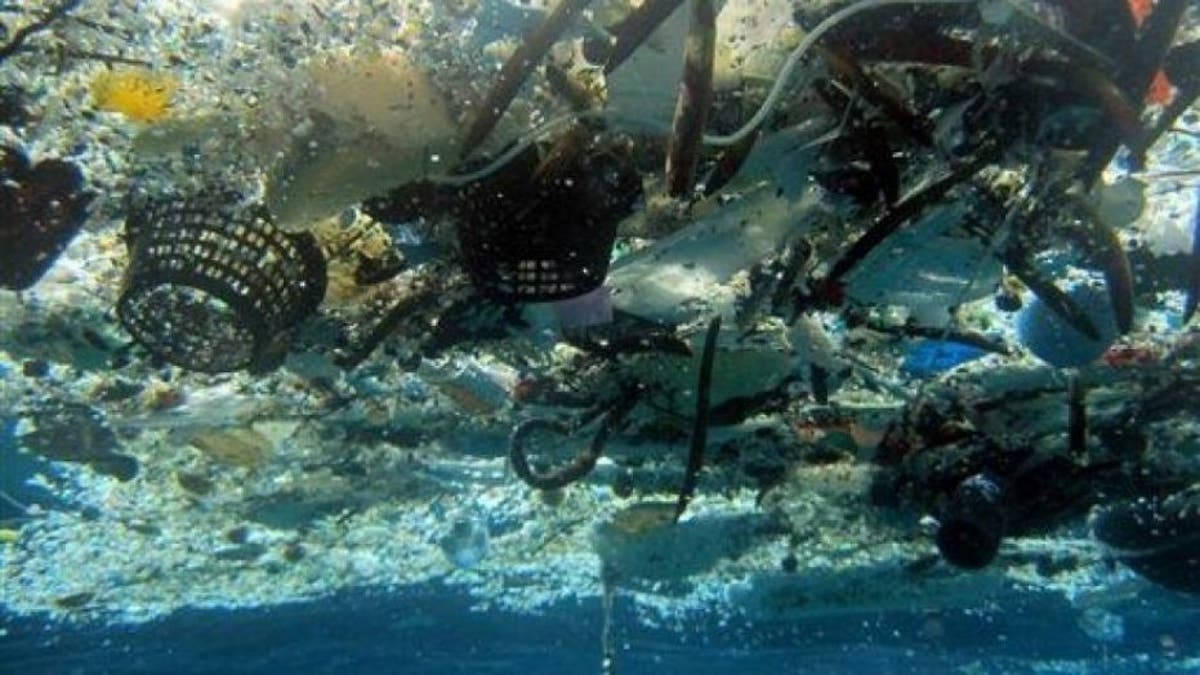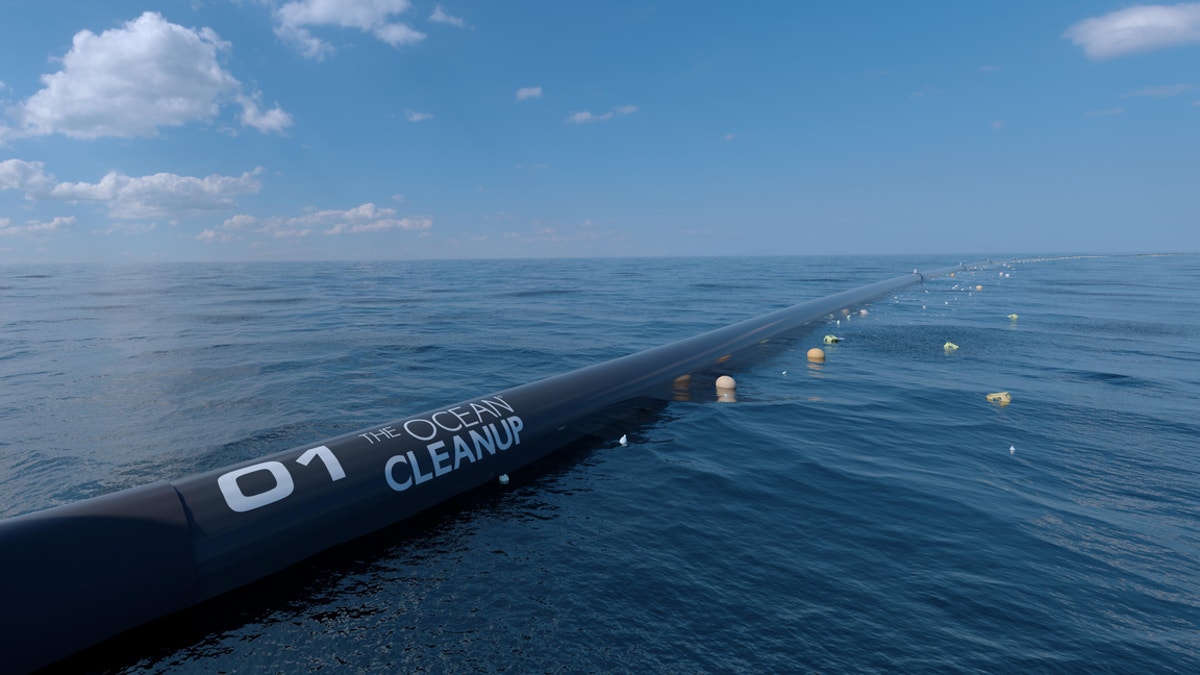
A "floating" island of trash dubbed the Great Pacific Garbage Patch (GPGP) now stretches 600,000 square miles. (AP Photo/NOAA Pacific Islands Fisheries Science Center)
An elaborate plan masterminded by a college dropout to help rid the Pacific Ocean of a Texas-sized island of garbage will kick off next month.
While it sounds promising, some experts have expressed concern about the impact it could have on marine life — as well as the message it's sending.
Dutch inventor Boyan Slat, the 24-year-old CEO of The Ocean Cleanup, is spearheading the multi-million dollar project to clear a "floating" island of trash dubbed the Great Pacific Garbage Patch, which now stretches 600,000 square miles between California and Hawaii. The group will start conducting tests on Sept. 8.
GREAT PACIFIC GARBAGE PATCH, FLOATING 'ISLAND' OF TRASH IN OCEAN, IS NOW TWICE THE SIZE OF TEXAS
Slat's plan involves a 2,000-foot-long, U-shaped contraption that will float on top of the water, using a screen attached below to collect plastic and other debris. The floating barrier will then concentrate the plastic garbage at a central point where it can be fished out of the water and shipped back to dry land for recycling.
"The screen is impenetrable, the current will flow underneath the screen, guiding with it organisms that can't actively move, while the plastic (which floats) remains inside the system," The Ocean Cleanup explains on its website.

The Ocean Cleanup performed hundreds of scale model tests over the years to ensure the vessel would be able to handle rough currents. (The Ocean Cleanup)
Eben Schwartz, marine debris program manager for the California Coastal Commission, said he believes the organization has the "best intentions" but they're only tackling a small percentage of overall plastic entering the oceans each year.
"Eight million metric tons [of trash] are entering the world's oceans every single year," Schwartz told Fox News. "Their project could be wildly successful cleaning the surface, but they're only tackling a minuscule percentage."
Schwartz, who has met with members of The Ocean Cleanup and toured their test facility, clarified that he hopes the project is a "huge success." However, he has concerns with some of the rhetoric the group is spreading.
SPERM WHALE SWALLOWS 64 POUNDS OF TRASH, DIES OF 'GASTRIC SHOCK'
The Ocean Cleanup estimates they will be able to get rid of roughly 90 percent of ocean plastic from every ocean gyre — huge parts of the ocean where swirling currents concentrate the trash — by 2040.
This staggering statistic concerned some experts, like Schwartz.
"My biggest concern isn't the project itself, it's the messaging that's coming out," Schwartz explained. "They're cleaning only what's on the surface. We see plastic throughout water columns, on the ocean floor, deposited in polar ice caps. The problem is much, much much larger than the messaging suggests."
Instead of skimming the surface, Schwartz suggested tackling the root of the problem and educating the public about what they cando to help prevent trash from escaping into the environment.
Richard Thompson, head of the International Marine Litter Research Unit at the University of Plymouth in the U.K., echoed Schwartz's advice.
"The way the ocean works I think it would be near impossible for there to be zero impacts to marine wildlife from this device trapping everything at the surface."
"If we consider cleanup to be a center stage solution, then we accept it is OK to contaminate the oceans and that our children and our children’s children will continue to clean up the mess," Halden told USA Today.
However, The Ocean Cleanup says it has never condoned the message that it's "OK" to litter, adding that they don't believe their method is the only solution to the problem either.
"The Ocean Cleanup strongly supports efforts to stop plastic waste entering the ocean but in no way does The Ocean Cleanup think cleaning up makes it 'OK to litter.' While cleaning up persistent floating ocean plastic is only one part of the equation, it is the only solution to an existing problem. Even if we stop all plastic from entering the oceans, we have to face the fact there are huge amounts of plastic in the ocean that needs to be cleaned up before it breaks down into smaller parts," the organization told Fox News via email.
Schwartz said many volunteers get to see first-hand the negative impact single-use disposable plastics make during California Coastal Cleanup Day, the state's largest annual volunteer event which is taking place this year on September 15.
PLASTIC CONTAINERS POSE HEALTH RISKS FOR CHILDREN, PEDIATRICIANS WARN

The Ocean Cleanup is deploying a vessel made up of several pipes between California and Hawaii to trap garbage at the surface. (The Ocean Cleanup)
"We see dramatic increases in people's knowledge of the causes of marine debris impacts by the end of the cleanup," said Schwartz, adding that The Ocean Cleanup should consider hosting similar educational events.
The Ocean Cleanup claims it has not diminished the problem of pollution plaguing our oceans — and adds it simply wants to tackle the issue before things get worse. It has also helped educate the public by sharing its research findings.
"Ocean Cleanup has never underestimated the problem and always said the ocean plastic problem is huge: if all the plastic is left in the ocean, it will eventually break down into microplastics, which are all the more difficult (if not impossible) to catch and all the more easy to ingest by marine life," The Ocean Cleanup said.
Schwartz then voiced concerns about the impact The Ocean Cleanup's project will have on marine life. The cleanup vessel, which is made up of a set of connected pipes, will hang a 9-foot-long net below it to help trap garbage.
"The way the ocean works I think it would be near impossible for there to be zero impacts to marine wildlife from this device trapping everything at the surface," Schwartz explained. "It'll be trapping krill, plankton ... which makes it a potential feeding ground for animals."
Ocean Cleanup, however, has defended its model and argues there are several systems put in place to protect marine life.
The vessel's slow speed, impenetrable screen and people checking for signs of marine life as the screen is lifted from the water will help avoid any casualties, Ocean Cleanup states.
"We have also conducted an Environmental Impact Assessment (EIA) through an independent agency, CSA Ocean Sciences, which did not identify any major risks of our method to the environment," the group added.
The Associated Press contributed to this report.




















